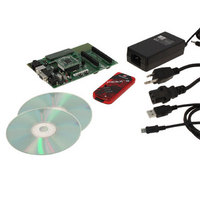DV164136 Microchip Technology, DV164136 Datasheet - Page 328

DV164136
Manufacturer Part Number
DV164136
Description
DEVELOPMENT KIT FOR PIC18
Manufacturer
Microchip Technology
Series
PIC®r
Type
MCUr
Datasheets
1.DM183032.pdf
(38 pages)
2.DV164136.pdf
(448 pages)
3.DV164136.pdf
(6 pages)
4.DV164136.pdf
(446 pages)
5.DV164136.pdf
(4 pages)
6.DV164136.pdf
(18 pages)
Specifications of DV164136
Contents
Board, Cables, CDs, PICkit™ 3 Programmer, Power Supply
Processor To Be Evaluated
PIC18F8722, PIC18F87J11
Interface Type
RS-232, USB
Operating Supply Voltage
3.3 V, 5 V
Silicon Manufacturer
Microchip
Core Architecture
PIC
Core Sub-architecture
PIC18
Silicon Core Number
PIC18F
Silicon Family Name
PIC18F8xxx
Kit Contents
PIC18 Exp Brd PICkit 3 Cable CD PSU
Lead Free Status / RoHS Status
Lead free / RoHS Compliant
For Use With/related Products
PIC18F8722, PIC18F87J11
Lead Free Status / Rohs Status
Lead free / RoHS Compliant
Available stocks
Company
Part Number
Manufacturer
Quantity
Price
Company:
Part Number:
DV164136
Manufacturer:
MICROCHIP
Quantity:
12 000
- DM183032 PDF datasheet
- DV164136 PDF datasheet #2
- DV164136 PDF datasheet #3
- DV164136 PDF datasheet #4
- DV164136 PDF datasheet #5
- DV164136 PDF datasheet #6
- Current page: 328 of 448
- Download datasheet (8Mb)
PIC18F87J11 FAMILY
FIGURE 24-5:
24.5.2
The fail-safe condition is terminated by either a device
Reset or by entering a power-managed mode. On
Reset, the controller starts the primary clock source
specified in Configuration Register 2H (with any
required start-up delays that are required for the oscil-
lator mode, such as OST or PLL timer). The INTRC
oscillator provides the device clock until the primary
clock source becomes ready (similar to a Two-Speed
Start-up). The clock source is then switched to the
primary clock (indicated by the OSTS bit in the
OSCCON register becoming set). The Fail-Safe Clock
Monitor then resumes monitoring the peripheral clock.
The primary clock source may never become ready
during start-up. In this case, operation is clocked by the
INTRC oscillator. The OSCCON register will remain in
its Reset state until a power-managed mode is entered.
24.5.3
By entering a power-managed mode, the clock
multiplexor selects the clock source selected by the
OSCCON register. Fail-Safe Clock Monitoring of the
power-managed
power-managed mode.
If an oscillator failure occurs during power-managed
operation, the subsequent events depend on whether
or not the oscillator failure interrupt is enabled. If
enabled (OSCFIF = 1), code execution will be clocked
by the INTRC multiplexor. An automatic transition back
to the failed clock source will not occur.
If the interrupt is disabled, subsequent interrupts while
in Idle mode will cause the CPU to begin executing
instructions while being clocked by the INTRC source.
DS39778D-page 328
Note:
Sample Clock
CM Output
EXITING FAIL-SAFE OPERATION
FSCM INTERRUPTS IN
POWER-MANAGED MODES
OSCFIF
Device
Output
Clock
The device clock is normally at a much higher frequency than the sample clock. The relative frequencies in
this example have been chosen for clarity.
(Q)
clock
FSCM TIMING DIAGRAM
source
resumes
CM Test
in
the
24.5.4
The FSCM is designed to detect oscillator failure at any
point after the device has exited Power-on Reset (POR)
or low-power Sleep mode. When the primary device
clock is either the EC or INTRC modes, monitoring can
begin immediately following these events.
For HS or HSPLL modes, the situation is somewhat
different. Since the oscillator may require a start-up
time considerably longer than the FSCM sample clock
time, a false clock failure may be detected. To prevent
this, the internal oscillator block is automatically config-
ured as the device clock and functions until the primary
clock is stable (the OST and PLL timers have timed
out). This is identical to Two-Speed Start-up mode.
Once the primary clock is stable, the INTRC returns to
its role as the FSCM source.
As noted in Section 24.4.1 “Special Considerations
for Using Two-Speed Start-up”, it is also possible to
select another clock configuration and enter an alternate
power-managed mode while waiting for the primary
clock to become stable. When the new power-managed
mode is selected, the primary clock is disabled.
Note:
CM Test
Oscillator
Failure
POR OR WAKE-UP FROM SLEEP
The same logic that prevents false
oscillator failure interrupts on POR, or
wake from Sleep, will also prevent the
detection of the oscillator’s failure to start
at all following these events. This can be
avoided by monitoring the OSTS bit and
using a timing routine to determine if the
oscillator is taking too long to start. Even
so, no oscillator failure interrupt will be
flagged.
© 2009 Microchip Technology Inc.
Detected
Failure
CM Test
Related parts for DV164136
Image
Part Number
Description
Manufacturer
Datasheet
Request
R

Part Number:
Description:
Manufacturer:
Microchip Technology Inc.
Datasheet:

Part Number:
Description:
Manufacturer:
Microchip Technology Inc.
Datasheet:

Part Number:
Description:
Manufacturer:
Microchip Technology Inc.
Datasheet:

Part Number:
Description:
Manufacturer:
Microchip Technology Inc.
Datasheet:

Part Number:
Description:
Manufacturer:
Microchip Technology Inc.
Datasheet:

Part Number:
Description:
Manufacturer:
Microchip Technology Inc.
Datasheet:

Part Number:
Description:
Manufacturer:
Microchip Technology Inc.
Datasheet:

Part Number:
Description:
Manufacturer:
Microchip Technology Inc.
Datasheet:











